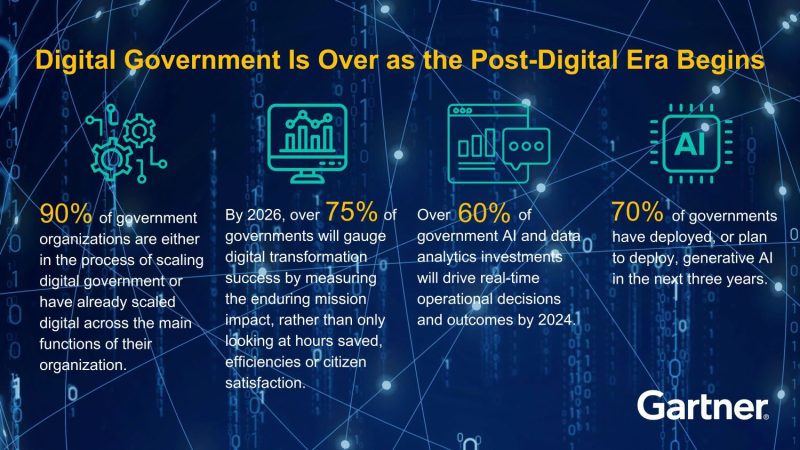By Dean Lacheca, VP Analyst at Gartner
Digital is no longer a qualifier for how governments deliver services – it’s distracting. Mission outcomes is all that counts. After more than 20 years of digital technology investments, it’s time for government organizations to prepare for when digital transformation is no longer a driver for change.
The transition to digital government has accelerated rapidly in recent years and many governments are now moving into a post-digital era. This is where the business case for further investment has to offer more than the diminishing returns from further efforts to improve citizen experience or deliver administrative efficiencies. Business cases must be able to offer benefits that are directly linked to the mission or public purposes of the department or agency.
According to Gartner, up to 90% of government organizations are either in the process of scaling digital government or have already scaled digital across the main functions of their organization. So why should any more money be spent on technology?
Post-digital government requires organizations to reset their ambitions and focus on their public purpose. Gartner predicts by 2026, over 75% of governments will gauge digital transformation success by measuring the enduring mission impact, rather than only looking at hours saved, efficiencies or citizen satisfaction.
Setting a more ambitious target, even in times of austerity and growing technical debt, forces governments to look differently at the capabilities and approaches they are using today. Delivering enduring mission outcomes requires them to find the moments that matter, which means building cognitive empathy for the needs of citizens and stakeholders.
Governments must leverage data insights to both anticipate optimal engagement and effectively react to the unexpected. They must also look to develop an orchestrated ecosystem of partners centered around shared outcomes.
Embracing cognitive empathy
How do we get to the heart of what really matters to the individuals involved, going beyond just delivering a digital service or a transactional engagement? The answer is to develop cognitive empathy capabilities, building a more complete and accurate understanding of stakeholders as people. Also, the critical moments that are going to make a difference and how governments have an impact on them.
To achieve this, governments must identify direct and indirect stakeholders and understand the journey they’re going through during a particular transaction or engagement. This is not about understanding a transactional flow. It will help them chart how stakeholder needs change at different points, and what creates frustration, distrust, discomfort or engagement.
A need-driven approach must be taken for all stakeholders involved and address those needs as effectively as possible. This approach allows critical moments to be identified, stakeholder engagement to be optimized, and knowledge on when to be reactive or proactive.
Human-centered design (HCD) is an approach that encapsulates this. It involves problem solving with empathy as a cornerstone, putting the citizen at the heart of the solution.
Leveraging data insights
To pivot the experience towards the optimal outcome, post-digital government requires hyper-personalized services that combine these empathy insights with real-time, actionable operational insights during the decision-making process. Gartner predicts over 60% of government AI and data analytics investments will drive real-time operational decisions and outcomes by 2024.
A Gartner survey conducted in April-May 2023 of 161 government organizations showed that 70% of governments have deployed, or plan to deploy, generative AI in the next three years.
This accelerating adoption of AI offers new pathways to data insights. Governments are using AI to capture new data that was previously not available and unlocks the value of existing data. But to have a real impact, new real-time data insights must be operationalized into ways of working.
Governments must be able to map the flow of data, turn that data into insight, understand how that insight impacts a decision and turn that into a tangible action.
Orchestrating ecosystems
Governments have always operated in some form of an ecosystem, often orchestrated around the department or agency. But digital ecosystems are changing the way society works and shifting the expectations of citizens. An ecosystem orchestrated around a shared problem, or outcome, is more likely to innovate and deliver the enduring mission outcomes desired by all government.
To orchestrate these ecosystems requires careful assessment of stakeholder value and incentive – which could be anything from establishing a shared platform, offering access to a subset of government data, enabling comprehensive engagement with the citizens involved, or shared facilities and resources.
Each of these new and enhanced capabilities required to successfully transition into a post-digital government era require new supporting technologies that will need to be incorporated into your technology roadmap going forward. Governments don’t invest just because it is a good idea, so you must be able to link these technology roadmaps to the mission outcomes focus of the post-digital era.
Source: PC & Associates Consulting
